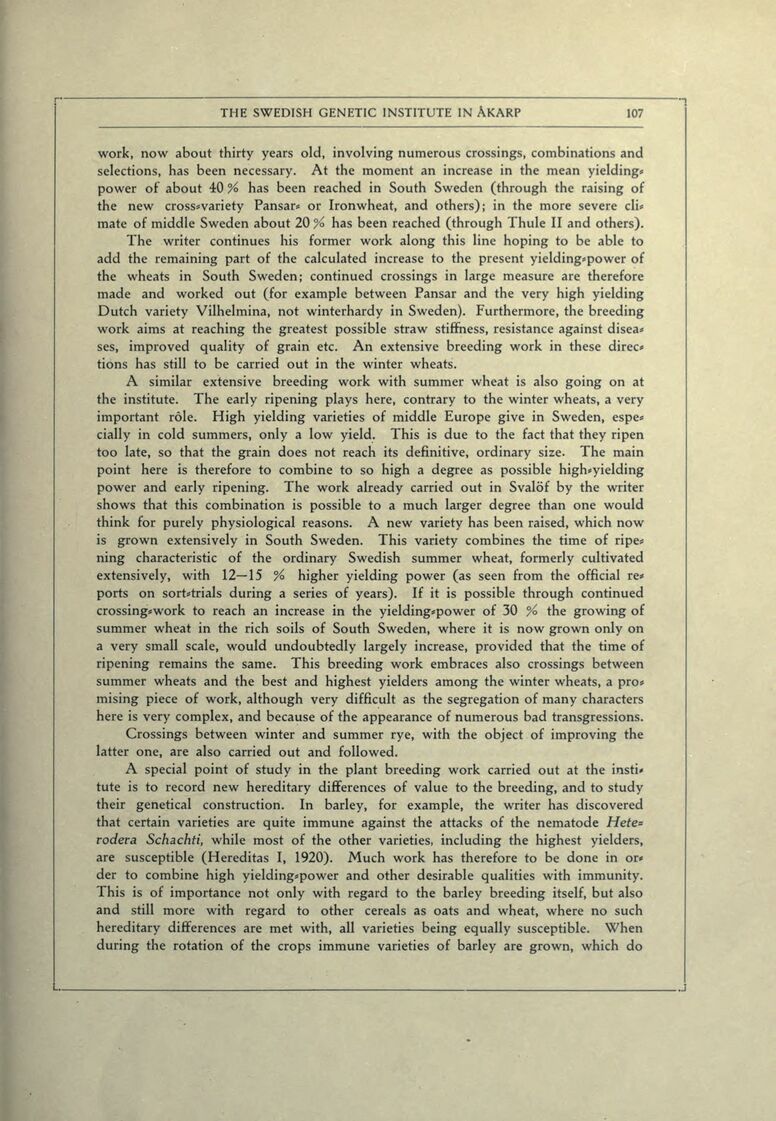
Full resolution (JPEG) - On this page / på denna sida - Part I - Professor Herman Nilsson-Ehle, Lund, Some Remarks on the Work of the Swedish Genetic Institute in Åkarp

<< prev. page << föreg. sida << >> nästa sida >> next page >>
Below is the raw OCR text
from the above scanned image.
Do you see an error? Proofread the page now!
Här nedan syns maskintolkade texten från faksimilbilden ovan.
Ser du något fel? Korrekturläs sidan nu!
This page has never been proofread. / Denna sida har aldrig korrekturlästs.
work, now about thirty years old, involving numerous crossings, combinations and
selections, has been necessary. At the moment an increase in the mean yielding*
power of about 40 % has been reached in South Sweden (through the raising of
the new cross*variety Pansar* or Ironwheat, and others); in the more severe cli*
mate of middle Sweden about 20 % has been reached (through Thule II and others).
The writer continues his former work along this line hoping to be able to
add the remaining part of the calculated increase to the present yielding*power of
the wheats in South Sweden; continued crossings in large measure are therefore
made and worked out (for example between Pansar and the very high yielding
Dutch variety Vilhelmina, not winterhardy in Sweden). Furthermore, the breeding
work aims at reaching the greatest possible straw stiffness, resistance against disea*
ses, improved quality of grain etc. An extensive breeding work in these direc»
tions has still to be carried out in the winter wheats.
A similar extensive breeding work with summer wheat is also going on at
the institute. The early ripening plays here, contrary to the winter wheats, a very
important röle. High yielding varieties of middle Europé give in Sweden, espe*
cially in cold summers, only a low yield. This is due to the faet that they ripen
too late, so that the grain does not reach its definitive, ordinary size. The main
point here is therefore to combine to so high a degree as possible high*yielding
power and early ripening. The work already carried out in Svalöf by the writer
shows that this combination is possible to a much larger degree than one would
think for purely physiological reasons. A new variety has been raised, which now
is grown extensively in South Sweden. This variety combines the time of ripe*
ning characteristic of the ordinary Swedish summer wheat, formerly cultivated
extensively, with 12—15 % higher yielding power (as seen from the official re*
ports on sort*trials during a series of years). If it is possible through continued
crossing*work to reach an increase in the yielding*power of 30 % the growing of
summer wheat in the rich soils of South Sweden, where it is now grown only on
a very small scale, would undoubtedly largely increase, provided that the time of
ripening remains the same. This breeding work embraces also crossings between
summer wheats and the best and highest yielders among the winter wheats, a pro*
mising piece of work, although very difficult as the segregation of many characters
here is very complex, and because of the appearance of numerous bad transgressions.
Crossings between winter and summer rye, with the object of improving the
latter one, are also carried out and followed.
A special point of study in the plant breeding work carried out at the insti*
tute is to record new hereditary differences of value to the breeding, and to study
their genetical construction. In barley, for example, the writer has discovered
that certain varieties are quite immune against the attacks of the nematode
Hete-rodera Schachti, while most of the other varieties, including the highest yielders,
are susceptible (Hereditas I, 1920). Much work has therefore to be done in or*
der to combine high yielding*power and other desirable qualities with immunity.
This is of importance not only with regard to the barley breeding itself, but also
and still more with regard to other cereals as oats and wheat, where no such
hereditary differences are met with, all varieties being equally susceptible. When
during the rotation of the crops immune varieties of barley are grown, which do
<< prev. page << föreg. sida << >> nästa sida >> next page >>